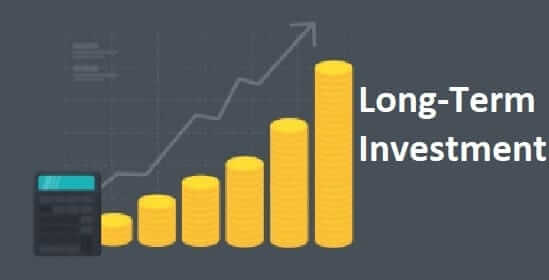But how do you know which long-term investments to choose?
In our Best Long-Term Investments in 2019 guide, we’re going to present 15 asset classes that we think you should take a closer look at. This will include the likes of stocks and share, ETFs, mutual funds, real estate and more.
By the end of reading our guide, you’ll have the required information to begin your long-term investment journey.
Before we get started with our top 15 picks, let’s quickly clarify what we mean by a long-term investment.
What is a Long-Term Investment?
As the name suggests, a long-term investment is a financial asset that you hold on a long-term basis. In terms of defining long-term, in the online investment sector this is generally considered to be an investment that you hold for at least a year. However, in many cases this can be much longer.
One of the key characteristics of a long-term investment is that activity levels are significantly more passive than short-term investing. In other words, once an asset has been purchased, investors are able to sit back and allow their investment to do their thing on the open marketplace.
This isn’t to say that research isn’t required. On the contrary, traders still need to be aware of any micro or macro economic events that might have a direct impact on their investment. Nevertheless, this is managed on a passive basis, rather than active.
In terms of the overarching aims of a long-term investment, this can be broken down in to two key forms – income and growth.
Earning Income via a Long-Term Investment
When experienced traders refer to an ‘income’ based investment, they are making reference to an investment that yields regular cash flows. This can come in a number of forms, such as a blue-chip stocks investment that pays quarterly dividends, or a real-estate investment that pays monthly rental payments.
Generally speaking, these types of long-term investments are lower risk, as investors seek to gain steady, but regular growth in the form of income.
Earning Appreciation via a Long-Term Investment
An additional form of growth that traders like to see in a long-term investment is that of appreciation. For those unaware, appreciation refers to an asset that increases in value in the open marketplace.
Sticking with same examples as above, this could include a long-term stocks investment that achieves growth on the stock exchange, meaning that the underlying share price increases in value and thus, rewards the investor with higher returns.
In the real estate market, this could be a property that is worth more on the open marketplace, meaning that once sold, the investor will receive more money that what they paid.
Ultimately, it is always hoped that a long-term investment can achieve growth both in the form of income, as well as appreciation. However, when choosing an asset class to invest in, traders often choose an investment based on the types of growth it most commonly achieves.
15 Best Long-Term Investment for 2019
So now that we’ve explained what a long-term investment actually is, as well as the difference between income-based growth and appreciation-based growth, we are now going to present to you 15 of the best long-term investments for 2019.
Take note, we’ve decided to focus on the underlying asset class or industry, with the hope that you will be able to perform additional research in to the specific asset that you want to invest in.
1. Cryptocurrencies
If there’s ever a long-term investment to consider for the future, then cryptocurrencies are at the very top of our list. Often described as the ‘Future of Money, cryptocurrencies such as Bitcoin and Ethereum allow users to send and receive funds without requiring the services of a third-party intermediary.
This decentralized payments network is supported by an innovative technology called the blockchain, which in itself is being trialed by some the world’s largest companies.
In terms of the underlying values, when Bitcoin – the world’s first and still de-facto cryptocurrency of choice, was initially launched in 2009, it carried a value that amounted to just a fraction of a cent.
Fast forward 8 years to 2017 and the very same asset achieved an all-time value of just under $20,000. As such, those who put faith in the revolution of digital currencies at the very start of its journey are now potentially millionaires.
It is important to note that since the cryptocurrency industry went through record highs in late 2017, the markets have since cooled-down quite considerably. In fact, at the time of writing in March 2019, Bitcoin is now worth in the region of $4,000.
However, many analysts believe that cryptocurrencies will play a major role in the future of finance and thus, their long-term potential is possibly limitless. If you feel that it’s worth a ‘punt’, then at $4,000 many would argue that you can now invest on the cheap.
Take note, cryptocurrencies are extremely volatile, and potentially one of the most high-risk asset classes operating in the financial sphere. As such, if you’re looking to invest in cryptocurrencies for the future, you’ll need to be able to ride some stormy waves.
Nevertheless, if cryptocurrencies is something that you would like to add to your long-term portfolio, then there are a number of ways that this can be achieved.
Firstly, you can go through the standard channels of purchasing cryptocurrencies via a third-party cryptocurrency exchanges, and then storing them in a decentralized wallet for safe keeping. Alternatively, if you want to keep things simple, you can trade cryptocurrencies via a CFD broker such as Plus500.
2. Blue-Chip Stocks
One of the most popular investment vehicles for long-term investing is that of blue-chip stocks. This refers to the art of investing in the large corporations that are publicly listed on major stock exchanges such as the New York Stock Exchange (NYSE) or NASDAQ.
As noted above, investing in stocks and shares can provide growth on two fronts – income and/or appreciation. Although some blue-chip stocks yield growth on both fronts, some do not pay dividends and thus, are suited to those that are looking for growth in the form of appreciation.
One of the largest companies in the world that is infamous for not paying their shareholder’s dividends is that of Amazon, so why do people buy Amazon stock. Instead, investors see growth in the form of appreciation on the NASDAQ stock exchange, meaning they can sell their shares for more than what they paid.
On the other hand, companies such as Apple reward their investors with smaller dividends when they buy Apple stocks that usually fall within the 1-2% range, alongside very healthy appreciation gains.
If you’re looking for long-term investments in the blue-chip stocks space, then you will need to use an online broker. If you’re looking for stocks that have a good history of share value growth, then it might be worth considering a CFD platform such as Plus500.
Alternatively, as CFD brokers are not conducive for dividend payments, you can use a traditional online broker such as Ally Invest.
3. Mutual Funds
If you like the sounds of long-term investing, but you don’t have the know-how to select your own assets, then you’re probably best suited for a mutual fund. This particular asset class utilizes the services of highly established fund managers, meaning that they manage your investments on your behalf.
In effect, they do all of the work for you, such as evaluating what assets to invest in, as well as the execution of trades. Moreover, each mutual fund will have their own risk-levels attached to it, meaning you can invest in a fund that suits your appetite for risk.
Mutual funds will also ensure that your investments are diversified across multiple assets, with the view of further mitigating the underlying risk.
In return for actively managing your funds, you will need to pay the fund manager in the form of an expense ratio. This is usually determined by an annual percentage fee that is calculated against the amount you have invested. Moreover, they’ll also likely take a percentage of any profits that the fund manages to make.
Although you have to pay for such services, you have to remember that you are tapping in to years of knowledge and expertise. While this comes at a cost, this will hopefully be countered from the gains that the fund manager makes on your behalf.
If you’re looking to invest in a mutual fund, this can be done via an established third party broker.
4. Real Estate
When it comes to asset classes that have the capacity to yield both regular income and long-term appreciation, nothing quite beats real estate. In fact, real estate is often described as the most secure long-term asset class in the investment space.
One of the key reasons for this is that people will always need somewhere to live. The underlying bricks and mortars provide real-world value and thus, attracts income in the form of monthly rental payments.
This is further amplified by a housing market that consistently yields home owners with yearly appreciation gains. Although the real estate space does go through occasional dips, generally speaking the long-term outlook is nothing but lucrative.
In terms of making a long-term investment in to the real estate sector yourself, this can be somewhat tricky. The reason for this is that unless you have a a substantial amount money at your disposal, you might struggle to get a look-in.
The good news is that there are a couple of alternative options. Firstly, there are a number of leading ETFs (exchange traded funds) that track specific housing markets.
Such ETFs usually track the movements of major companies that operate in the space, such as real estate agents or property developers. The only caveat with the ETF route is that you won’t be accustomed to rental income dividends.
The other option you have is to use a crowdfunding platform. If you’re interested in an investment in the UK real estate space, then the likes of Property Partner allow you to invest as little as you want, with the funds pooled together with other investors.
Although you’ll pay 2% per transaction fee, you’ll be accustomed to both appreciation gains (when the house is sold) and monthly rental dividends that are proportionate to your investment.
5. Bonds
Much like in the case of real estate, bonds are also considered to be one of the safest long-term investment channels. Bonds are essentially loans that are issued to governments or corporation. As these loans are of significant size, the funds are raised by multiple investors – known as bond holders.
The way bonds work is that you will receive fixed interest payments over a fixed period of time. For example, if you invested $10,000 in to U.S. treasury bonds on a 10-year fixed term, you might receive annual interest payments of around 2%. At the end of the 10-year term, you would then receive your original $10,000 investment back in full.
The reason bonds are defined as low risk is that generally speaking, both governments and large-scale corporations are unlikely to default. However, it should also be noted that like all asset classes, bonds come in a range of risk-levels.
If you decide to purchase bonds from a higher-risk institution – such as a government operating in a weaker economy, then your interest yields will be much higher than the types of bonds issued by leading powerhouses such as the U.S. or Germany. Furthermore, the longer the term of the bond agreement, the higher the interest yield.
However, this will of course attract higher levels of risk.
Although some bond agreements can span 10, 20 or even 50 years, investors always have the option of trading them on the open marketplace. The real-world market value is determined by the underlying risk levels, which in itself is determined by market forces.
6. Gold
Some estimates argue that the origins of Gold dates all the way back to 643 B.C, whereby it was used as a form of currency for centuries to follow. In today’s age, Gold is instead viewed as a store of value, meaning that it is an excellent mechanism to protect wealth.
Just like in the case of all commodities that attract value, Gold can be traded on the open marketplace. As such, there is no requirement to physically purchase or store Gold if you want to make an investment.
The easiest way to do this is to either invest in a Gold ETF, or via a CFD platform such as Plus500. Both channels essentially track the movement of Gold prices in real-time, which is based on global supply and demand.
Although Gold can be used as a long-term store of value, its price can fluctuate quite widely in the open markets.
If you’re looking to make an investment and you’re able to ride out market volatility, then Gold has excellent long-term potential. One of the key drivers to Gold increasing in value is when the financial markets go through turbulent times. This is because Gold’s status as a store of value protects investors from market down-falls.
Don’t forget, Gold is purely an appreciation-based investment, meaning that it won’t generate you any growth in the form of regular income.
7. Legal Marijuana Stocks
This particular pick from our list of the best long-term investments in 2019 is potentially the most controversial. However, it should be recognized that the legal marijuana industry is currently experiencing exponential growth.
This mainly boils down to relaxed policy making from government institutions, which is crucial for the legal marijuana industry to flourish. This can be broken down in to two key segments – medical and recreational.
First, the medical marijuana segment refers to marijuana purchases that require a medical prescription. This segment of the industry is now completely legal in more than 30 U.S. states, multiple E.U. nations, and many other jurisdictions around the word.
The second segment, and potentially the most lucrative in terms of revenues, is that of the recreational marijuana industry. At the time of writing, on top of 9 U.S. states, just two nations have made recreational marijuana usage legal – notably Canada and Uruguay.
With all that being said, if governmental attitudes towards marijuana usage continues to favor the industry, then investing in marijuana-based stocks could be an excellent long-term investment.
This mainly centres around companies that legally grow and distribute the marijuana, and those that are engaged in drug-based research and development. One such example of this is Cronos Group, who are a Canadian-based grower listed on the Toronto Stock Exchange.
If you like the sounds of a long-term investment in to the ever-growing marijuana space, you can back a range of listed companies via a CFD broker such as Plus500.
8. ETFs
Although we have briefly mentioned ETFs already, it is important to recognize just how much of a useful investment vehicle they can be for long-term investors. The overarching reason for this is that they have the capacity to track virtually any class. Moreover, these are often asset classes that would otherwise be very difficult to speculate on in the traditional sense.
For example, think about an investment in to the wider utilities sector. This includes the likes of water, power, electricity and natural gas – things that are a necessity for all.
Attempting to investing in this broad marketplace would be ultra-complex, not least because you would potentially need a portfolio that contained dozens, if not hundreds of individual companies operating in these key sectors.
On the contrary, ETFs allow you to invest, among practically all other sectors, in to the wider utilities space via a single trade. One such example of this is the hugely popular Fidelity MSCI Utilities ETF.
This particular ETF tracks the movement of around 67 stocks linked to the utilities space, and the fund contains assets worth close to half a billion dollars. A further benefit to ETFs is that fees are usually very low. In the case of the Fidelity MSCI Utilities ETF, you’ll pay an annual fee of just 0.084%, meaning a $5,000 investment would cost you just $4.20 in fees.
Once again, ETF risk-levels will depend on the asset class or industry you are backing, and they only yield appreciation, as opposed to dividend growth.
9. Stock Market Indices
Although we have already covered blue-chip stocks, it is also important to recognize the benefits of investing in stock market indices. In a nutshell, indices allow you to invest in the performance of the wider stock markets, rather than investing in individual companies.
This is a great long-term investment strategy for two key reasons. Firstly, stock market indices are a good choice for investors that do not want to choose companies on their own accord. Instead, you can simply back a large number of companies that operate on a particular stock market.
Secondly, stock market indices carry considerably less risk than backing individual companies. This is because you are essentially diversifying your risk across multiple companies that will be operating in multiple sectors.
As such, if certain companies within the index perform badly, it is hoped that this is countered by the remaining companies that constitute the indices.
When it comes to choosing indices, many options exist. For example, the likes of the NASDAQ, NYSE, Tokyo Stock Exchange (TSE) and London Stock Exchange (LSE) are all represented by leading indices.
On of the most popular of these is the S&P 500. This particular indices tracks the share price movement of the largest 500 companies operating in the U.S. This covers stocks listed on both the NASDAQ and NYSE, meaning your risk levels are mitigated quite considerably.
If you want to invest in a stock market indices, you can do this via an index fund, ETF or even a CFD broker.
10. IPOs
Initial Public Offerings (IPOs) are a great way to purchase newly listed stocks on the cheap. This is the process whereby companies decide to list publicly on a stock exchange. In return for investing capital into the company in question, investors receive equity in the form of shares.
The reason that IPOs are great for long-term investing is that generally speaking, share prices should be at their lowest when the company first goes public. This is because companies are in the business to make money and thus, growth is usually represented in the organisation’s share price.
To illustrate the potential of investing in IPOs, when social media giant Facebook listed on the NASDAQ exchange back in 2012, shares were priced at just $38.22. Although the stock initially went through a market correction, Facebook hit $218 in July 2018 – illustrating growth levels of more than 473% in just over 6 years.
When it comes to making an investing into an IPO, this is slightly more tricky in comparison to stocks already listed on an exchange. The reason for this is that due to the size of IPO share allocations, access is primarily reserved for accredited or institutional investors.
However, certain brokers such as Hargreaves Lansdown are often able to purchase batches of IPO equities, and subsequently sell them back to their clients.
11. Crowdfunding
Although carrying slight similarities to an IPO, crowdfunding is a financial mechanism that allows you to invest in new startups. The idea is that in return for backing a new company, you receive equity that is proportionate to the amount you invested.
In the vast majority of cases these will be small companies that are just beginning their enterprise journey, and they won’t be listed on any public exchanges. Instead, they are private companies that operate without shares, meaning that all decisions are made internally by management.
The most common way of backing startups is via crowdfunding platforms such as Kickstarter. This allows you you to invest really small amounts, which is something not usually possible when engaging with IPOs.
In terms of seeing a return on your investment, this can come in two main forms. If and when the company you back issues dividends, you’ll receive a payment that is proportionate to your investment. Secondly, and potentially the most lucrative, is if the startup gets purchased by a larger company.
If this does happen, you’ll likely receive considerably more than you initially invested. Just remember, it can take many years for startups to grow, so you’ll need to sit on your investment long-term.
Nevertheless, one of the most successful stories from a Kickstarter crowdfunding campaign is that of Oculus. The startup raised $2.4 million in its respective fundraising campaign in 2012, later being purchased by Facebook two years later for a whipping $2 billion.
12. Artificial Intelligence
If you’re looking for a specific industry that has the potential to make it super big in the long-term, then it might be worth exploring the world of artificial intelligence (AI).
To illustrate just how lucrative AI is as a highly innovative technology, it is estimated that the industry will be worth close to $191 billion by the year 2024.
As the phenomenon is still relatively new, at least from the perspective of the financial markets, the easiest way to back the growth of the industry is to invest in stocks that have a direct interest in AI.
One such example of this is Nvidia, who aim to be the “standard AI platform” of choice. This includes key technologies that aim to revolutionize the autonomous vehicles space. Listed on the NASDAQ exchange, Nvidia stocks can be bought via CFD broker Plus500, or through a traditional online stockbroker.
An additional player in the AI space that appears to gaining momentum is Yext. Listed on the NSYE, Yext have had their AI protocols integrated into major platforms including Facebook, Amazon and Google.
13. Oil
As one of the most sought after commodities in the world, oil is something that is required by all. In fact, the real-world use case for oil far exceeds just fuelling cars. This includes everyday items that require oil in the underlying production process, such as plastics, tars, lubricants and chemicals.
Regardless of its end-use, oil is a commodity that has a finite supply. In other words, as supply levels become tighter and tighter, demand for oil will subsequently follow suit.
You don’t need to physically purchase oil to invest in its underlying value. On the contrary, you can easily invest in ETFs or CFDs that track its real-world value in the open marketplace.
This value is ultimately derived by supply and demand, meaning that price movements can at times be volatile. Moreover, these supply levels are often artificially controlled by OPEC (The Organization of the Petroleum Exporting Countries), who are known to dictate production levels with the view of controlling its price.
As such, oil is a somewhat higher-risk investment in the short-term, however in the long-run, it is likely that its value will continue to rise in response to ever-growing increase in demand levels.
The most pertinent risk to oil demand is the growth of renewable energy sector. However, this segment of the energy space is still in its absolute infancy and thus, is considerably small in comparison to conventional crude oil.
14. Annuities
Although this section of our best long-term investment guide will only appeal to those in the later stages of their life, annuities are a notable option if you are approaching retirement.
For those unaware, an annuity is a pension-based plan that sees an individual invest a lump sum. In return for investing a lump sum, the individual will receive fixed-monthly pension payments for the rest of their life.
The amount of fixed-income that you are likely to receive is mainly based on the total sum lump that you are able to invest. Moreover, rates will vary from provider-to-provider. Ultimately, annuities are a long-term investment into your retirement years.
However, jumping into an annuities agreement is not a decision that should be taken lightly. In fact, you’ll probably want to seek guidance from an independent financial adviser.
The key reason for this is that once an annuity agreement has been finalized, it is virtually impossible to reverse.
In some cases, an annuity is an excellent long-term value proposition, as it affords the individual with life-long security. However, they are not always suitable, not least because your current pension plan might already offer better long-term value.
15. Debt Mutual Funds
This particular asset class is one of the lowest risk long-term investments that you can make. Essentially, debt mutual funds are a cross-over between low-risk bonds and mutual funds.
The reason for this is that your fund manager will invest in ultra-low risk instruments on your behalf, which will likely include U.S./Euro treasury bills and government securities. In return for your investment, you’ll receive very steady, long-term interest payments.
The overarching idea is that at the very least, you’ll be able to out-perform annual inflation figures with the view of protecting your wealth.
Much like in the case of conventional mutual funds, you’ll need to employ the services of a fund manager. Although this will be accustomed to an annual expense, don’t forget that you are utilizing the services of a highly experienced investor.
Long-Term Investment Strategies
If you’re looking for some potential strategies that will help you kick-start your long-term investment journey, then we’ve listed 10 useful tips for you to consider.
1. Research
Although this point might sound somewhat obvious, one of the most important tips we can give you is to spend ample time researching your chosen asset. Although you’ll be required to spend a lot less time doing this in comparison to short-term trading, it is still important to research the long-term potential of your investment.
This should include any key industry developments that are likely to effect the value of your investment. For example, if you’re investing in the marijuana industry, one the most important factors that you need to keep an eye out for is government regulation and policy making.
2. Patience
Unlike short-term investing, you are going to be holding on to your assets for a very long time. As such, it is almost certain that your chosen marketplace will experience turbulence along the way. Just because your investment goes through a period of decline, it doesn’t always mean that you should simply offload.
In many cases, bullish assets require a market correction, which is usually a result of institutional investors cashing out their gains. Be patient, as its key to long-term investing.
3. Consider What Types of Gains you Want to Target
As we discussed earlier, some assets are suitable for regular income, others for appreciation gains and some are a combination of the two. Whichever option you go for, it is important that you have a fundamental understanding as how you’re going to make money.
If you’re ever unsure which strategy is right for, your best bet is to invest in assets across both growth categories. This might include some high-yield dividend stocks alongside Gold-backed ETFs.
4. Understand Fees
Not only is it important to understand how you are going to achieve gains, but you also need to have a firm grasp of fees. No matter how good online brokers are at advertising, investments are never free.
In the vast majority of cases, you’ll either pay a flat-fee per trade, or a percentage of the total amount invested. This is important, as if you are only planning to invest smaller amounts, you don’t want to get crippled by constant flat-fees that are going to eat in to your potential profits. On the other hand, if you’re investing significant amounts, then a flat-fee is probably better.
5. Targets
Although long-term investing is more about sitting back in a passive manner, you should still formulate some key targets. While it is true that long-term investments should be held for extended income or appreciation gains, you always want to have an exit strategy.
For example, when the stock markets crashed in response to the 2008 financial crisis, it took a good few years before blue-chip companies recovered their losses. You would have been smart to exit at this point and re-enter the once it appeared the markets were beginning to bottom-out.
6. Re-Invest Dividends
If you’re looking to increase your wealth on a long-term basis, then you need to consider re-investing your gains. If this is in the form of dividends, then as soon as they are issued you should look to invest them back-in to one of your assets.
In the long-run, this will have the effect of compounding interest, as you’ll get the chance to earn growth on the money that you re-invest,
7. Diversify
One of most important factors that you need to consider as a long-term investor is diversification. This means that your investments are spread across multiple assets that operate in multiple spaces.
For example, you’ll likely want to diversify across stocks that operate in different industries, such as the financial, technology and retail segments. Moreover, your diversification strategy should also cover a range of asset classes, such as adding mutual funds, ETFs and cryptocurrencies on top of traditional shares.
8. Never Expect Market Recovery to be a Sure Thing
Although we previously mentioned that you need to be patient, you always need to recognize when it it time to exit a trade. Newbie investors often make the mistake that assets will eventually recover in the open marketplace, however this isn’t always the case.
History suggests that multiple companies that we were once told could never fail, did just that. Think the likes of the Lehman Brothers and Enron.
9. If You’re Unsure, Seek Professional Assistance
There is no shame in admitting that you just don’t know which assets to invest in. As there are literally tens of thousands of main-stream asset to choose from, knowing which ones to back can be a right headache.
To ensure that you don’t miss out on some key opportunities, you might be best to stick with actively managed mutual funds. Although this will be more expensive than going it alone, you’ll have an experienced investor managing your money on your behalf.
10. Never Invest More Than you can Afford to Lose
This last point is perhaps the most important. While the main objective of investing long-term is to make more money than what you started with, there is never any guarantee that this will happen.
As such, you should never invest more than you can afford to lose. If you want to play it safe, you could also consider investing regular, smaller amounts, instead of investing a lump sum.
Best Long-Term Investment Platforms
So now that we’ve covered the best 15 long-term investments of 2019, alongside 10 crucial investment strategies, we are now going to list 5 of the best platforms that can facilitate your long-term investment goals.
The platform that you decide to go with will depend on your individual circumstances, and should include key factors such as fees, user-friendliness and the type of assets that are listed.
Plus500
Plus 500 is a leading CFD broker that specializes in a full range of assets. If you’re looking for a straight-forward broker that hosts most than 2,000 securities, then it might be worth checking Plus500 out.
Alongside offering commission-free trades, the broker are one of the most established in the online investment space. This is further supported by their public listing on the LSE.
Pros:
✅ Established since 2008 – listed on the LSE
✅ Regulated and authorized by multiple jurisdictions
✅ Commission-free trades – everything included within the spread
✅ More than 2,000 securities to invest in
Cons:
❌ CFDs – so no access to dividends
80.5% of retail investor accounts lose money when trading CFDs with this provider. You should consider whether you can afford to take the risk of losing your money.
Ally Invest

If you’re not too keen on the CFD space, then it might be worth using a traditional broker such as Ally Invest. The platform covers thousands of assets, most of which focus on the stocks and shares space. In fact, you’ll pay just $4.95 per trade when using Ally Invest, which is highly competitive.
What you’ll also have access to at Ally Invest is company dividends from the stocks that you’re holding. Just remember, the platform is only available to U.S. residents or U.S. citizens based abroad.
Pros:
✅ Heavily regulated in the U.S.
✅ Stock trades from just $4.95 per trade
✅ Dividends paid straight into your cash account
Cons:
❌ Only available to U.S. customers
DeGrio
If you’re looking for a more traditional long-term broker but can’t use Ally Invest because you’re not based in the U.S., then it might be worth considering Dutch platform DeGiro. The company offers thousands of assets across multiple industries, both online and via your mobile device.
The biggest selling point to using the DeGiro platform is that they offer some of the lowest fees in the industry. This makes it viable if you are only looking to invest smaller amounts.
Pros:
✅ One of the cheapest brokers in the online space
✅ Access to thousands of assets across multiple markets
✅ Funds protected by E.U compensation scheme of up to €20,000
Cons:
❌ Does not accept debit or credit cards
Hargreaves Lansdown
Hargreaves Lansdown are one of the most established players in the traditional stock brokerage segment. They offer thousands of long-term investment vehicles which covers multiple stock markets, mutual funds and bonds. Moreover, if you’re looking to access the IPO space, then Hargreaves Lansdown can usually facilitate this for you.
Pros:
✅ Most long-term asset classes covered
✅ Long-standing reputation
✅ Access to IPOs
✅ Very good fundamental news department
Cons:
❌ Fees are on the higher side
Conclusion
In conclusion, if you’ve taken the time to read our guide in its entirety, then you should now have a very good idea as to what it takes to succeed in long-term investing. To help you along the way, we’ve discussed 15 of the best investment ideas for 2019 and beyond.
Whether its stocks and shares, ETFs, debt mutual funds or cryptocurrencies, we’ve suggested something for all risk levels.
Ultimately, if you have the right mind-set to engage in patient and passive investing, then you’ll no doubt get your long-term trading journey off on the right foot.
FAQs
How are long-term investments defined?
In its most basic form, a long-term investment is an investment that sees the asset held for at least one year. Anything less than this and you're in short-term investment territory.
How much time do I need to commit to long-term investments?
One the great aspects of long-term trading is that it is more of a passive investment strategy. As such, although you will still be required to perform independent research, this is significantly less time consuming than the short-term investment space.
How do I make money when my investments are long-term
When it comes to making money in the long-term investment space, this can be on two main fronts. You can make money in the form of dividends, which is a long-term income-based growth strategy.Alternatively, you can also make money when the underlying asset appreciates on the open marketplace. The best long-term investments are those that offer both revenue streams.
What is the lowest-risk long-term investment i can make?
If you're looking to invest long-term, but want to keep your risk-levels to an absolute minimum, the you might want to consider bonds. This is especially true with government bonds from strong economies, as it highly unlikely that the government is going to default.
What long-term investments offer the highest returns?
If you're familiar with the 'Risk vs Reward' model, then you'll know that the more risky an asset is, the higher the returns should be. In this like-for-like spectrum, you'll likely find cryptocurrencies at the very top. On the one hand, while cryptocurrencies are very high-risk, the potential returns are huge.
What do I do if I can't find any long-term investments to back?
If you're struggling to take the plunge, or simply not sure which assets to back, then you're probably best sticking with a long-term mutual fund. While this does come at a slight cost, you'll be using a highly experienced fund manager that looks after your investments on your behalf.




















